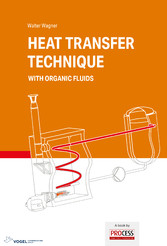Suchen und Finden
Prefaces and Table of Contents
9
Description of the Most Important Symbols
19
1 Introduction
23
2 Heat Transfer Fluids
27
2.1 General
27
2.2 Organic Heat Transfer Fluids
34
2.3 Silicone Oil-Based Heat Transfer Fluids
147
2.4 Glycol-Based Heat Transfer Fluids
159
3 Design of Heat Transfer Plants
175
3.1 Symbols, Flow Sheets and Abbreviations
175
3.2 Plant Systems
181
3.3 System Design of Plants with Forced Convection
185
3.4 System Additions
189
3.5 Plant Separation System to Atmosphere
190
3.6 Heat Transfer Fluid in the Collection Vessel
200
3.7 Parallel Connection of Heaters
203
3.8 Flow Connecting Possibilities of the Heat Consumer
206
3.9 Additions and Summary of the Plant Systems
210
3.10 Selection Criteria for the Plant System
212
3.11 Plants with Liquid and Vaporous Heat Transfer Fluid
213
3.12 Plant Data
219
3.13 System Performance Curve of the Plant
224
3.14 Safety Equipment
226
3.15 Design of Salt Melt Installations
237
3.16 Design of a Liquid Metal Installation
239
4 Fundamentals of Flow and Heat
245
4.1 Flow Rate of Heat Transfer Fluid
245
4.2 Pressure Losses on the Heat Transfer Fluid Side
249
4.3 Fundamentals of Heat
267
5 Heaters
301
5.1 Electric Heaters
301
5.2 Directly Fired Heaters
321
5.3 Heater Heated by Hot Gases
368
5.4 Heaters with External Furnaces
375
5.5 Heater Performance Field
379
5.6 Example of Calculation of the Highest Film Temperature in the Heater
384
5.7 Deposits and Stresses in the Heater Tube Wall
404
5.8 Measures to Prevent Explosions in the Heater
422
6 Plant Components
423
6.1 Heating
423
6.2 Circulating Pumps
472
6.3 Valves
554
6.4 Pipework
598
6.5 Tanks
622
7 Heat Consumers
631
7.1 Determination of the Heat Requirement
632
7.2 General Design Rules
635
7.3 Air Heaters
637
7.4 Stirrer Vessels, Containers and Tanks
638
7.5 Heat Exchangers
641
7.6 Steam Generators
643
7.7 Hot Tap Water Heaters
647
7.8 Cylinder Heating
648
7.9 Press Heating
653
7.10 Different Options for Heating and Cooling with Storage Tanks
655
7.11 Heating – Cooling – Chilling (H-C-C)
657
7.12 Pressure Rise Through the Influence of Heat on a Captive Liquid
660
7.13 Heat Consumers by Fields of Application
661
8 Measuring, Control and Circuit Technology
665
8.1 Measuring Technology
665
8.2 Control Technology
685
8.3 Limitation Technology
695
8.4 Circuit Technology
696
9 Installation Specifications
725
9.1 Installation of the Heaters
725
9.2 Heater Room Specifications
725
9.3 Stacks
729
10 Operation of Heat Transfer Plants
735
10.1 Acceptance Test
735
10.2 Cleaning
735
10.3 Leak Test
735
10.4 Filling of the Plant with Heat Transfer Fluid and Pressure Test
736
10.5 Function Test
737
10.6 Commissioning
738
10.7 Record of Measurements
739
10.8 Shutting-Down
740
10.9 Maintenance
740
10.10 Repairs
744
10.11 Systems for Increasing Operating Safety and InstallationAvailability
745
11 Statutes, Ordinances, Regulations, Standards and Specifications of the EU and DIN
767
12 Biomass CHP Plants with Organic Fluids(ORC Installations)
773
12.1 Energy from Wood Combustion
775
12.2 Intermediate Circuit Heat Transfer Fluid System
793
12.3 Turbine Circuit with Silicone Oil as the Fluid
831
12.4 Requirements for Heat Transfer Fluid Oil Installationswith Wood Firing Systems for ORC Power Generation
838
13 Equations, Diagrams and Tables for Project Planning for Heat Transfer Fluid Installationsin the Liquid Phase
847
13.1 Volume Flow V
848
13.2 Pipework Inner Diameter
849
13.3 Contents I
851
13.4 Expansion Volume
854
13.5 Expansion Line dExp and Vent Line dVent
856
13.6 Pressure Loss Calculation
857
13.7 Pump and Pump Motor Power Requirement PP and PM
860
13.8 Ratio of Thermal Power to Pump Power Q/PP
863
13.9 Measurement Orifice and Throttle Orifice dBL and dDr
864
13.10 Heat Transfer and Fluid Vapor Data
866
13.11 Flame-, Combustion Chamber- and Heater Dimensions
867
13.12 Technical Combustion Efficiency of a Heater ?F
870
13.13 Fuel Flow and Exhaust Gas Flow B and VA
872
13.14 Fan Power P
874
13.15 Stack Diameter for Liquid and Gaseous Fuels dS
875
13.16 Pipe Routing
875
13.17 Structural Calculations [13.5]
877
14 Overview Diagrams of Assemblies: Form Sheets with Sample Calculations
881
14.1 Form Sheets
881
14.2 Form Sheets with Sample Calculations
903
15 Properties of Organic Heat Transfer Fluids
921
1. Mineral Oil-Based Organic FluidsApplication Area: Approx. 50…250 °C
929
2. Synthesis-Based Organic FluidsApplication Area: Approx. 50… max. 400 °C
962
3. Organic Fluids for Heating-Cooling-Chilling ProcessesApplication Area: Approx. 50…300 °C
1017
4. Organic Fluids for the Food IndustryApplication Area: Approx. 100…300 °C
1039
5. Heat Transfer Fluids Based on Polyalkyleneglycol DerivativesApplication Area: Approx. 100…250 °C
1044
6. Organic Fluids for the Cleaning and Rinsing of Heat Transfer Installations
1047
16 Units and Conversion Tables
1049
17 Comparison of German and Foreign Rules andStandards
1071
17.1 Pipeline Components and Materials
1071
Sponsored Content
1109
Parabolic Trough Solar Power Plants – The Largest Thermal Oil Plants in the World
1111
Explosion Protection in Heat Transfer Systems with Organic Heat Transfer Fluids
1120
Increased Operational Safety and Plant Availability of aThermal Oil System
1125
New Technology for Heat Transfer Fluid Installations
1143
Increased Flexibility and Operational Reliability by Means of Remote Diagnostics
1155
Handling ?100 °C with a New Chiller System Safely andEconomically
1159
A 48-MW-Thermal Oil System for Crude Oil Extractionin China
1164
Tempering at Low Temperatures
1166
Carrying out Isothermal Processes up to 400 °C
1171
Sensory Combustion Optimisation of Gas Combustion Systems
1175
Don’t Ignore Thermal Stability
1185
Thermal Oil – A Standard with Unknown Depth
1193
“Proactive condition monitoring and maintenance ofyour heat transfer fluid is of equal importance tochoosing the correct fluid for your application.“
1197
Alle Preise verstehen sich inklusive der gesetzlichen MwSt.








